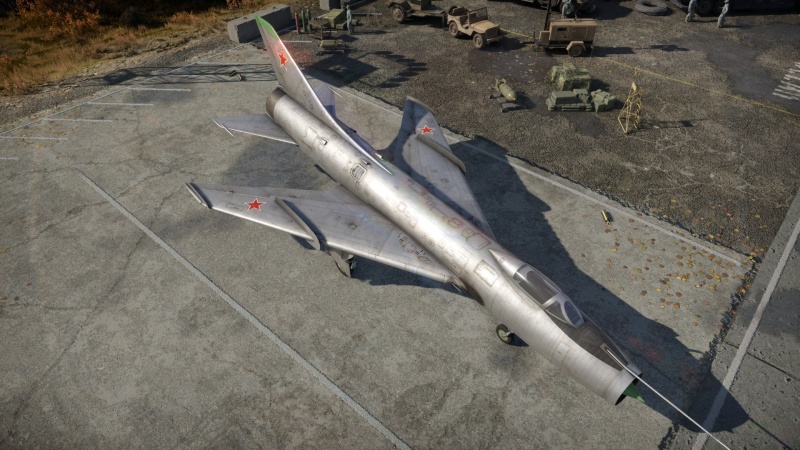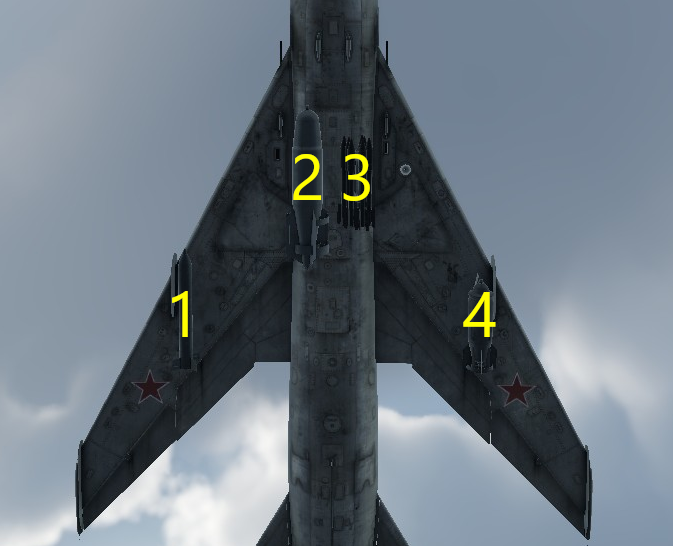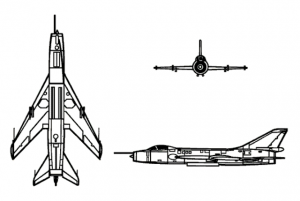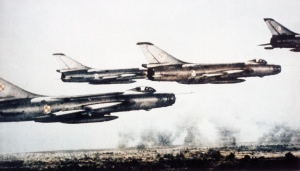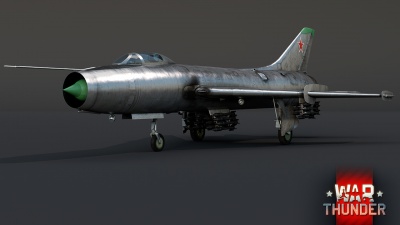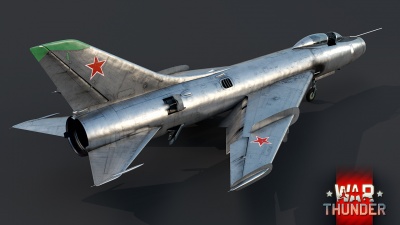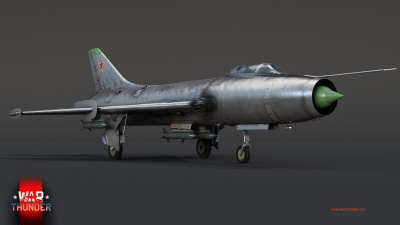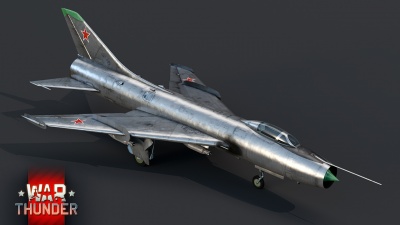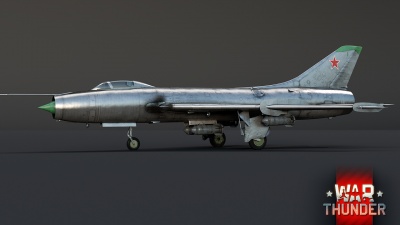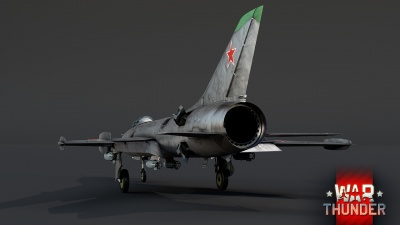Su-7B
| This page is about the Soviet strike aircraft Su-7B. For other versions, see Su-7 (Family). |
Contents
Description
The Su-7B was the first mass-produced variant of the Su-7. After the introduction of the Su-7, the fighter was reclassified as a fighter/bomber and the production was changed to the Su-7B. This strike aircraft was meant to fill the role of a fast fighter/bomber in the new Soviet Air Force doctrine of lightning strikes deep in enemy territory against NATO. The Su-7 was later improved and replaced by more newer variants, such as the Su-7BM and the Su-7BKL which was the most produced variant.
Introduced in Update "Starfighters", the Su-7B is a very capable fighter/bomber. Unlike many supersonic aircraft at its BR, the Su-7B has a very good acceleration and outspeeds almost any other supersonic fighter except for the MiG-21s and the F-104 Starfighters. For a strike aircraft it has a decent manoeuvrability, this allows it to fight aircraft like the MiG-21s and Harriers but without losing too much energy. However the Su-7B excels in terms of ground ordnance, even though it lacks any sort of guided munitions, it has ballistics computers for both bombs and rockets. It has enough payload to destroy a full base with the ZB-360 incendiary bombs and for ground RB it can use the S-24 or S-5K rockets.
General info
Flight performance
The Su-7B is characterised by a low BR for a supersonic jet and amazing acceleration. With a 1-1 thrust-weight ratio when at optimal fuel load and spaded, it can reliably punch above its weight. The Sukhoi accelerates extremely well, outspeeding every supersonic at its BR except for MiG-21s. The manoeuvrability isn't bad, either - It can easily turn with supersonic aircraft such as MiG-21s, Harriers or A-7s. However, you must keep in mind that the plane has a tendency to break its wings if in a sustained 9+G turn at high speeds, and that you are not invulnerable while turning. You are giant, almost twice as big as a MiG-21, so be sure to not overstay your welcome in a dogfight and zoom away as soon as possible.
| Characteristics | Max Speed (km/h at 11,000 m) |
Max altitude (metres) |
Turn time (seconds) |
Rate of climb (metres/second) |
Take-off run (metres) | |||
|---|---|---|---|---|---|---|---|---|
| AB | RB | AB | RB | AB | RB | |||
| Stock | 2,161 | 2,145 | 27.4 | 28.2 | 166.4 | 157.6 | 1,250 | |
| Upgraded | 2,323 | 2,232 | 26.6 | 27.0 | 227.0 | 195.0 | ||
Details
| Features | |||||
|---|---|---|---|---|---|
| Combat flaps | Take-off flaps | Landing flaps | Air brakes | Arrestor gear | Drogue chute |
| X | X | ✓ | ✓ | X | ✓ |
| Limits | ||||||
|---|---|---|---|---|---|---|
| Wings (km/h) | Gear (km/h) | Flaps (km/h) | Max Static G | |||
| Combat | Take-off | Landing | + | - | ||
| 1,260 | N/A | N/A | 473 | ~11 | ~3 | |
| Optimal velocities (km/h) | |||
|---|---|---|---|
| Ailerons | Rudder | Elevators | Radiator |
| < 700 | < 650 | < 600 | N/A |
Engine performance
| Engine | Aircraft mass | |||||
|---|---|---|---|---|---|---|
| Engine name | Number | Basic Mass | Wing loading (full fuel) | |||
| Saturn AL-7F-1-100 | 1 | 7,926 kg | 315 kg/m2 | |||
| Engine characteristics | Mass with fuel (no weapons load) | Max Takeoff Weight | ||||
| Weight (each) | Type | 8m fuel | 20m fuel | 27m fuel | ||
| 2,200 kg | Afterburning axial-flow turbojet | 8,756 kg | 10,000 kg | 10,726 kg | 13,043 kg | |
| Maximum engine thrust @ 0 m (RB / SB) | Thrust to weight ratio @ 0 m (WEP) | |||||
| Condition | 100% | WEP | 8m fuel | 20m fuel | 27m fuel | MTOW |
| Stationary | 5,848 kgf | 8,257 kgf | 0.94 | 0.83 | 0.77 | 0.63 |
| Optimal | 6,664 kgf (1,000 km/h) |
9,974 kgf (1,000 km/h) |
1.14 | 1.00 | 0.93 | 0.76 |
Survivability and armour
- 20 mm Aluminium Alloy - pilot's headrest
- 36 mm Aluminium Alloy - pilot's backrest
- 8 mm steel - cockpit front bulkhead
- 102 mm Bulletproof glass - Armoured windscreen
Modifications and economy
Armaments
| Ballistic Computer | |||
|---|---|---|---|
| CCIP (Guns) | CCIP (Rockets) | CCIP (Bombs) | CCRP (Bombs) |
| |
|
|
|
Offensive armament
The Su-7B is armed with:
- 2 x 30 mm NR-30 cannons, wing-mounted (80 rpg = 160 total)
The Su-7B comes equipped with 2 x 30 mm NR-30 cannons; these will be familiar to pilots which flew the succeeding Su-7BKL, or the MiG-19PT and MiG-21F-13 in the parallel line. The Su-7 has greater ammunition capacity than earlier MiGs with the gun, 160 rounds giving a trigger time of approximately 4.8 seconds. With velocity ranging from 780-785 m/s depending on the shell, this is much faster than the earlier NR-23 or N-37D found on earlier Soviet jets. This greatly simplifies aiming, and with the 67.14 g of TNTe filler found in the HEF-I and HEFI-T shells, hits from this cannon will usually cripple or destroy enemy aircraft on the first hit. As the Su-7BKL is a strike fighter the guns may also be used against armoured targets; the mix of AP-T with 48 mm penetration and APHE with 37 mm penetration, but 22.48 g TNTe of explosive filler will do significant damage to enemy armour. It is recommended to attack from above, as most enemy tanks have weak roof armour and can be more effectively penetrated from above.
Suspended armament
The Su-7B can be outfitted with the following ordnance:
| 1 | 2 | 3 | 4 | ||
|---|---|---|---|---|---|
| 250 kg OFAB-250sv bombs | 1 | 1 | 1 | 1 | |
| 500 kg FAB-500M-54 bombs | 1 | 1 | 1 | 1 | |
| ZB-360 incendiary bombs | 1 | 1 | 1 | 1 | |
| S-3K rockets | 7 | 7 | 7 | 7 | |
| S-5K rockets | 16 | 16 | 16 | 16 | |
| S-24 rockets | 1 | 1 | 1 | 1 |
| Default weapon presets | |
|---|---|
| |
Usage in battles
The Su-7B has a very good acceleration and can outspeed most jets, it can easily dodge incoming missiles by turning as it can turn and still maintain most of its speed (mind the G forces as it can easily break your plane apart and make the pilot lose consciousness). The Su-7B sports 30 mm NR-30 cannons and can also be equipped with both bombs and rockets for various types of playstyle. The Su-7B also comes with a rangefinding radar and the S-24 can be put on a distance fuse to be used in air combat.
Air combat
At the start of a match, take 27 minutes of fuel and equip Air targets belt. Start ascending on a 20-30° angle to an altitude of 7-9 km, your goal is to get behind the enemies in order to easily take care of them without their knowledge of your presence. Keep flying at this altitude and overfly enemy fighters. If there is an enemy at this altitude, feel free to engage into a head-on or dodge them. Keep flying above the enemies until there are none underneath you, turn around and start descending while keeping an eye on your speed. Go for the nearest enemy or slowest (A-10s for example). Get behind them and approach as fast as possible as speed is your greatest advantage. Start firing when you're close enough. If the enemy is eliminated, go for the next one, but if you missed do not engage into a dogfight: maintain your speed and go after the next target. If there are any AI planes, you can safely go after them and make use of your gyro linked gunsight to auto adjust your guns' distance. Align your plane behind the AI plane, put your gunsight's dot on the plane, and shoot a short burst of rounds (it is more precise in the first person view). After having expended your ammunition, you can return back to the base to continue fighting or swap tactics.
Attacking ground targets
At the start of a match, equip the 28 x S-3K rockets or the 64 x S-5K rockets (which will be helpful to take care of light and medium tanks). Start ascending on a 5° angle until above 1 km altitude, you will need the speed to quickly evade enemies and enemy missiles. It's best to flank and fly to the far sides of the map, so you can easily fly in a straight line and take care of ground targets one after the other. When firing at a ground target: any tank except for medium and heavy tanks requires a single hit by both rockets, while medium and heavy tanks would require 2 or more rockets. Always keep a eye on your surroundings as you're flying fast at a low altitude, which can catch the attention of enemy jets who will then try to engage you. Maintaining a high speed is important, in case a missile is fired at you. After depleting all of your rockets, you can head back to base to resupply rockets or start going after enemy players or AI planes.
Bombing bases
At the start of a match, equip the 4 x ZB-360 bombs (as that is enough to take care of a base). And start ascending on a 10° angle to 1-2 km, you might be behind everyone a little bit but the higher top speed and acceleration you will get on this altitude will make up for it. Start heading for any enemy base and keep this altitude. Avoid any head-on and beware of enemies below and above you with missiles that might eliminate you. When you're near the base, start diving, enable your airbrakes, and get into position to drop your payload. Once bombs have been dropped, you can head back to base for another bombing run or start going after enemy players, AI planes or ground targets. The choice is yours.
CAS ground
When flying the Su-7B, equip the 4 x S-24 rockets (as a single hit from these is enough to take care of any ground target). Start heading to the battle area and keep a high altitude to avoid SPAAs and enemy planes. Once close enough, start diving and search for targets to fire at. If there is a SPAA that starts shooting at you, prioritize it above everything else. If there are no SPAAs, fire a single rocket at a target and go after the next one (even if it misses the target, the rocket will overpressurize them). Once too low, start pulling up and gain altitude again, then repeat this process until you're out of rockets. You can then go to base to resupply or go after enemy planes, soft ground targets or helicopters.
Enemies worth noting
A-10A / A-10A Late: these American strike aircraft might seem slow but they have access to the mid-range and fast AIM-9L Sidewinder air-to-air missiles which are very accurate. It's almost impossible to dodge them even when flying above Mach 1.1. It's best to keep a distance from the A-10s, as the missiles have an all-aspect tracking and dodging them in a head-on is close to impossible. The best way to defeat the A-10 is from behind, as even from the sides the A-10 can quickly turn around and fire a missile. When coming at it from behind, approach as fast as possible as the A-10 is slow. Speed is your advantage to quickly win the fight if it doesn't respond fast enough. If you miss the attack, quickly turn back around and hope that the A-10 won't fire its missile at you. After a missed interception it's best to leave the A-10 and go after other targets as now the A-10 is aware of your presence, and going for a second interception would be taking an unnecessary risk.
Radars
The Su-7B is equipped with a SRD-5 rangefinding radar, located in the nose of the aircraft. It will automatically detect other planes within the scanning area and display the range to the closest target. It is linked with a gyro gunsight and can help with aiming at close range.
| SRD-5 - Rangefinding radar | |||
|---|---|---|---|
| Maximum Tracking Range |
Minimum Tracking Range |
Azimuth Tracking Angle |
Elevation Tracking Angle |
| 3,000 m | 300 m | ±9° | ±9° |
Pros and cons
Pros:
- One of the fastest planes at its battle rating
- Very fast acceleration
- 2 x 30 mm cannons are very powerful against ground and air targets alike
- Decent energy retention
- Time-fused S-24 rockets can be useful in head-ons
- The gyro-linked gunsight changes distance automatically up to 1,000 m thanks to rangefinding radar
Cons:
- Large silhouette, easy to hit
- NR-30 cannons depletes ammunition quickly
- S-24 as anti-air are situational, unlike conventional IR missiles
- No countermeasures
- High risk of wing overload due to high-G manoeuvres, especially with negative-G
- No air-to-air missiles
History
On May 14th 1953, shortly after Stalin's death and the reopening of the Sukhoi OKB, they began work on a swept-wing front-line fighter. Their first prototype was named S-1 and was fitted with the all-new Lyulka AL-7 turbojet. It was the first Soviet aircraft to utilize the all-moving tailplane and a translating centerbody, plus a dramatic wing sweep of 60°, irreversible hydraulically boosted controls, and an ejection seat of Sukhoi's own design. After the success of the S-1, production began with the S-2. later renamed the Su-7.
Later, on 31 July 1958, the Soviet Tactical Aviation tasked Sukhoi with developing a ground-attack variant of the Su-7, which could replace the scrapped Ilyushin IL-10. The resulting prototype, S-22, incorporated structural refinements for high-speed, low-altitude operations. It first flew in March 1959 and entered service in 1961 as the Su-7B.
Devblog
With the development of jet aviation, piston-engined attack aircraft quickly became an anachronism; a need arose for a new class of front-line aircraft - a fighter bomber. In the USSR, the MiG-15 and MiG-17 fighter jets were used to replace the piston-engined IL-10 to support the ground forces from the air, but it was quite obvious that a specialized machine was needed to fulfill the tasks of the fighter-bomber. The most suitable candidate was the Sukhoi Su-7 fighter jet, taken as the basis for the Su-7B fighter-bomber project. By the end of 1958, the first prototype was ready with the new AL-7F-1 engine. For almost two years, the aircraft underwent intensive testing and refinement, and in 1960 the new fighter-bomber went into mass production. Of the 431 planned, 344 Su-7Bs were built to equip up to 25 combat units. From the beginning of the 1970s, the Su-7B aircraft began to be replaced with more modern modifications and models.
Media
- Skins
- Images
- Videos
See also
- Related development
External links
- [Devblog] Su-7B: new doctrine
- Official data sheet - more details about the performance
- [Special] Su-7B military pilot interview
| Sukhoi Design Bureau (Сухого Опытное конструкторское бюро) | |
|---|---|
| Jet fighters | Su-9 · Su-11 |
| Su-27 | Su-27 · Su-27SM |
| Strike aircraft | |
| Su-2 | BB-1 · Su-2 (M-82) · Su-2 MV-5 · Su-2 TSS-1 |
| Su-6 | Su-6 · Su-6 (AM-42) · Su-6 (M-71F) |
| Su-7 | Su-7B · Su-7BKL · Su-7BMK |
| Su-8 | Su-8 |
| Su-17 | Su-17M2 · Su-17M4 · Su-22M3 |
| Su-24 | Su-24M |
| Su-25 | Su-25 · Su-25BM · Su-25K · Su-25T · Su-25SM3 · Su-39 |
| Su-34 | Su-34 |
| Export | ◊Su-22UM3K · ◔Su-22M3 · ◊Su-22M4 · ◄Su-22M4 WTD61 |
| J-11* | |
| *CKD and SKD kits assembled by Shenyang Aircraft Corporation | |
| USSR jet aircraft | |
|---|---|
| Bereznyak-Isayev | BI |
| Yakovlev | Yak-15 · Yak-15P · Yak-17 · Yak-23 · Yak-28B · Yak-30D · Yak-38 · Yak-38M · Yak-141 |
| Mikoyan-Gurevich | MiG-9 · MiG-9 (l) · MiG-15 · MiG-15bis · MiG-15bis ISh · MiG-17 · MiG-17AS · MiG-19PT |
| MiG-21F-13 · MiG-21PFM · MiG-21S (R-13-300) · MiG-21SMT · MiG-21bis | |
| MiG-23M · MiG-23ML · MiG-23MLD · MiG-27M · MiG-27K | |
| MiG-29 · MiG-29SMT | |
| Lavochkin | La-174 · La-15 · La-200 |
| Sukhoi | Su-9 · Su-11 |
| Su-7B · Su-7BKL · Su-7BMK · Su-17M2 · Su-17M4 · Su-22M3 | |
| Su-24M | |
| Su-25 · Su-25BM · Su-25K · Su-25T · Su-25SM3 · Su-39 | |
| Su-27 · Su-27SM | |
| Su-34 | |
| Ilyushin | IL-28 · IL-28Sh |
| Tupolev | Tu-14T |



